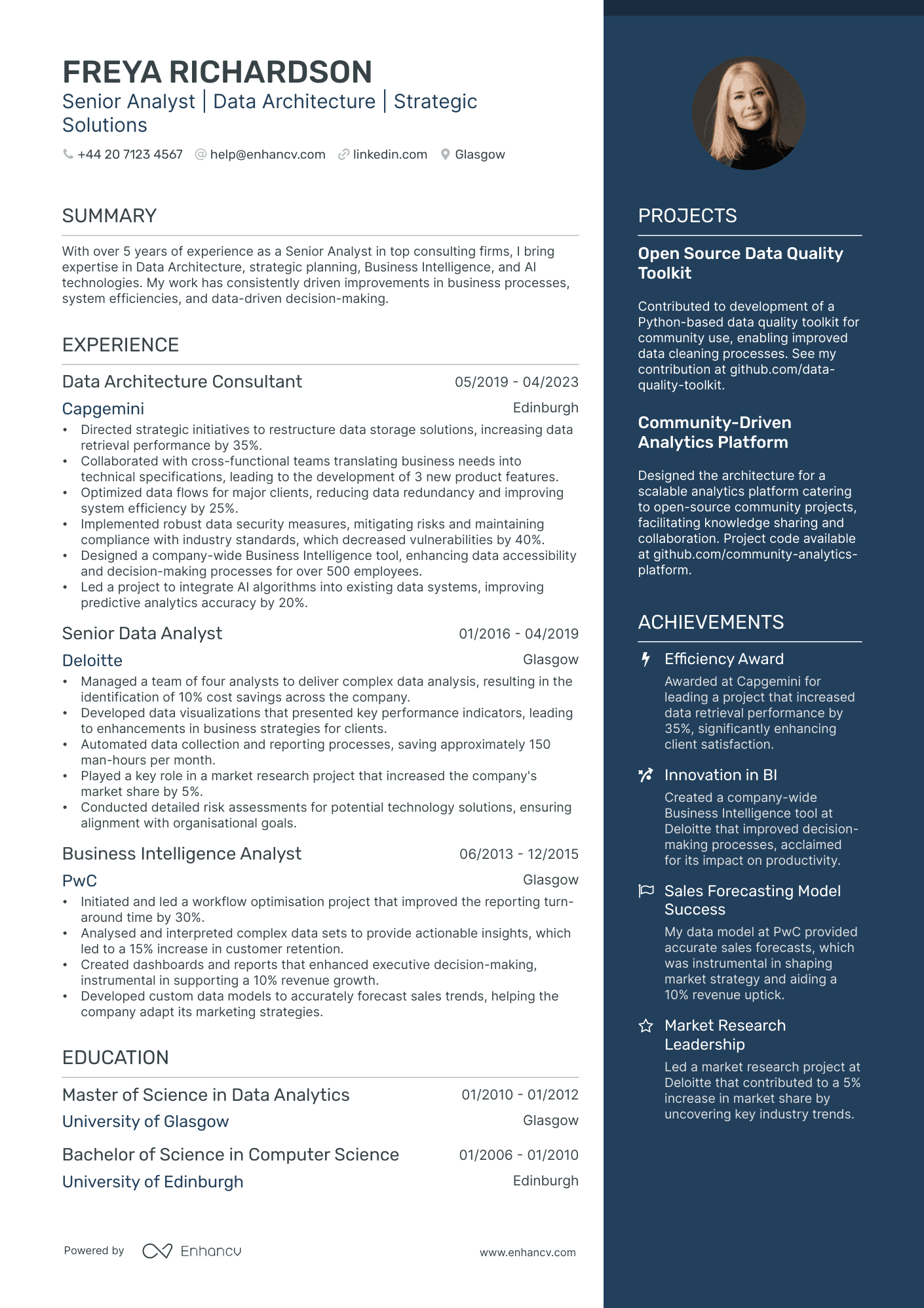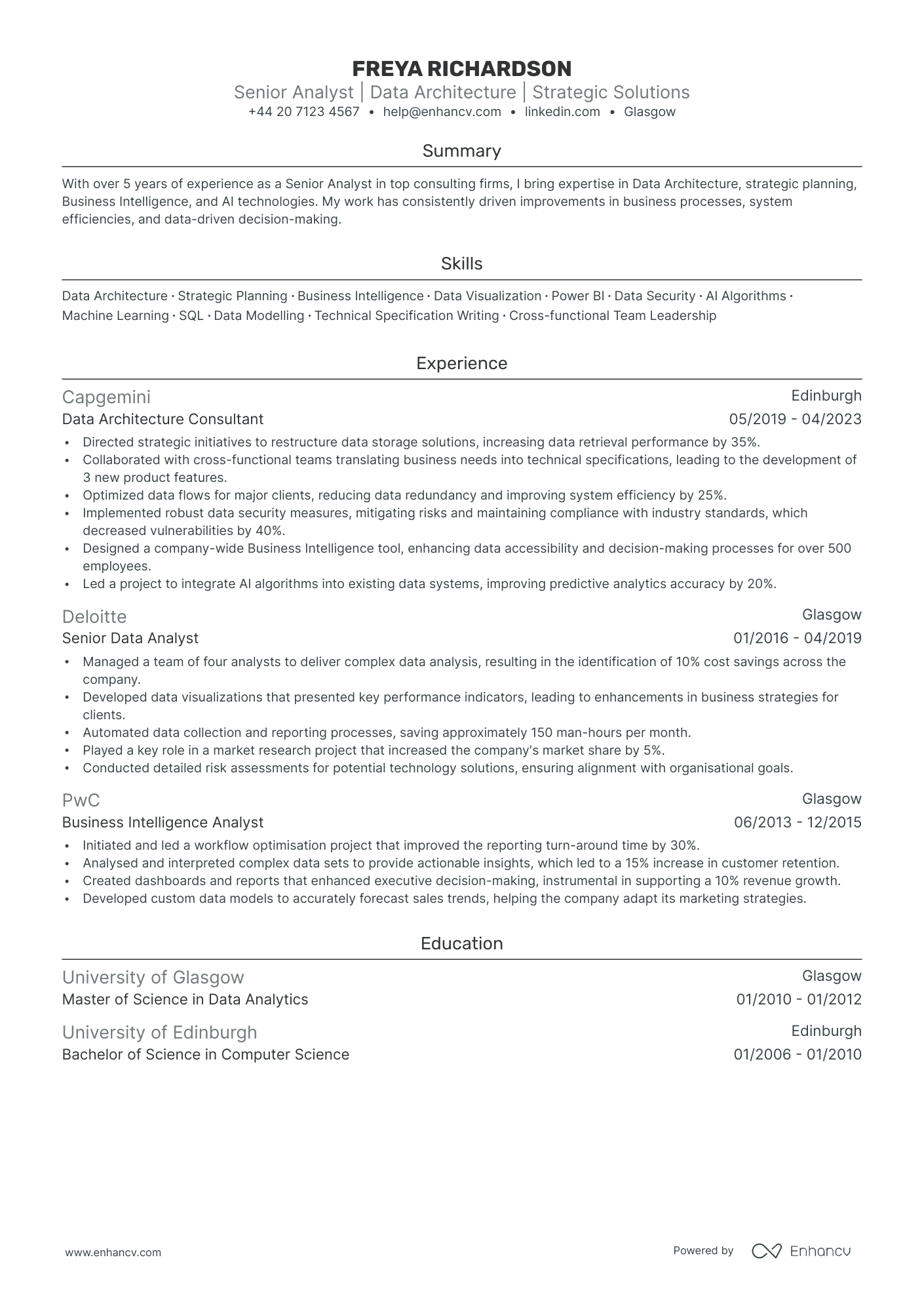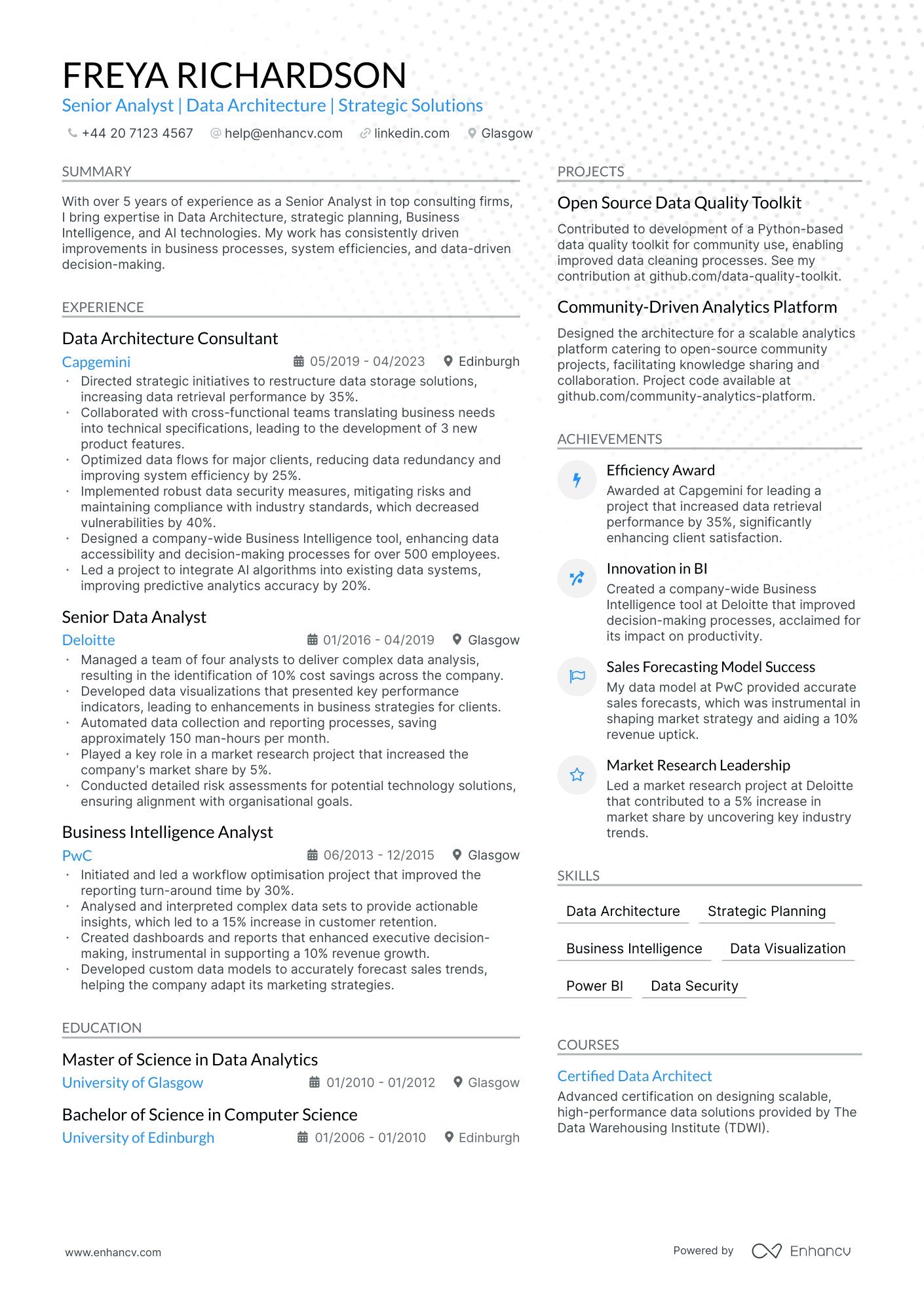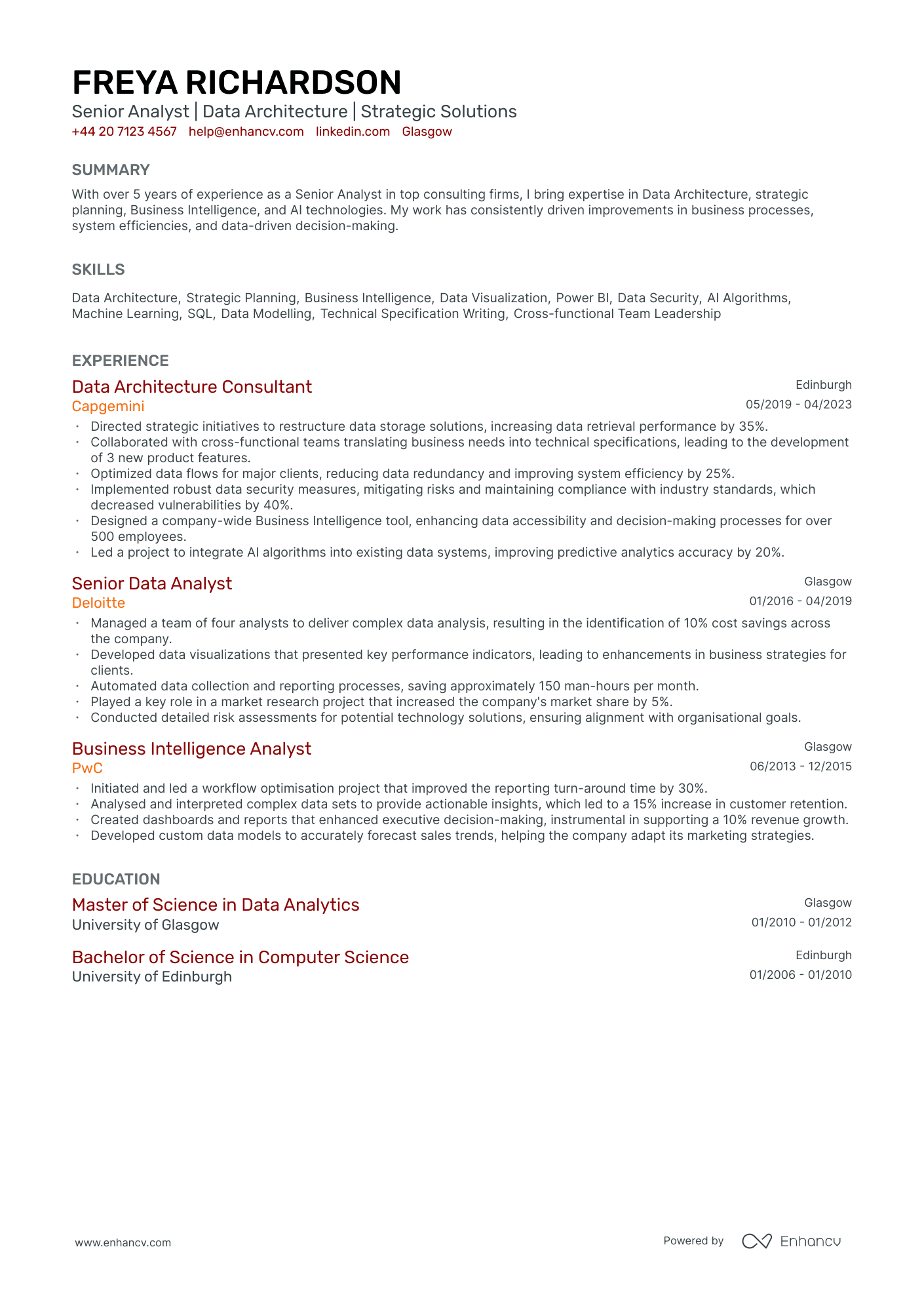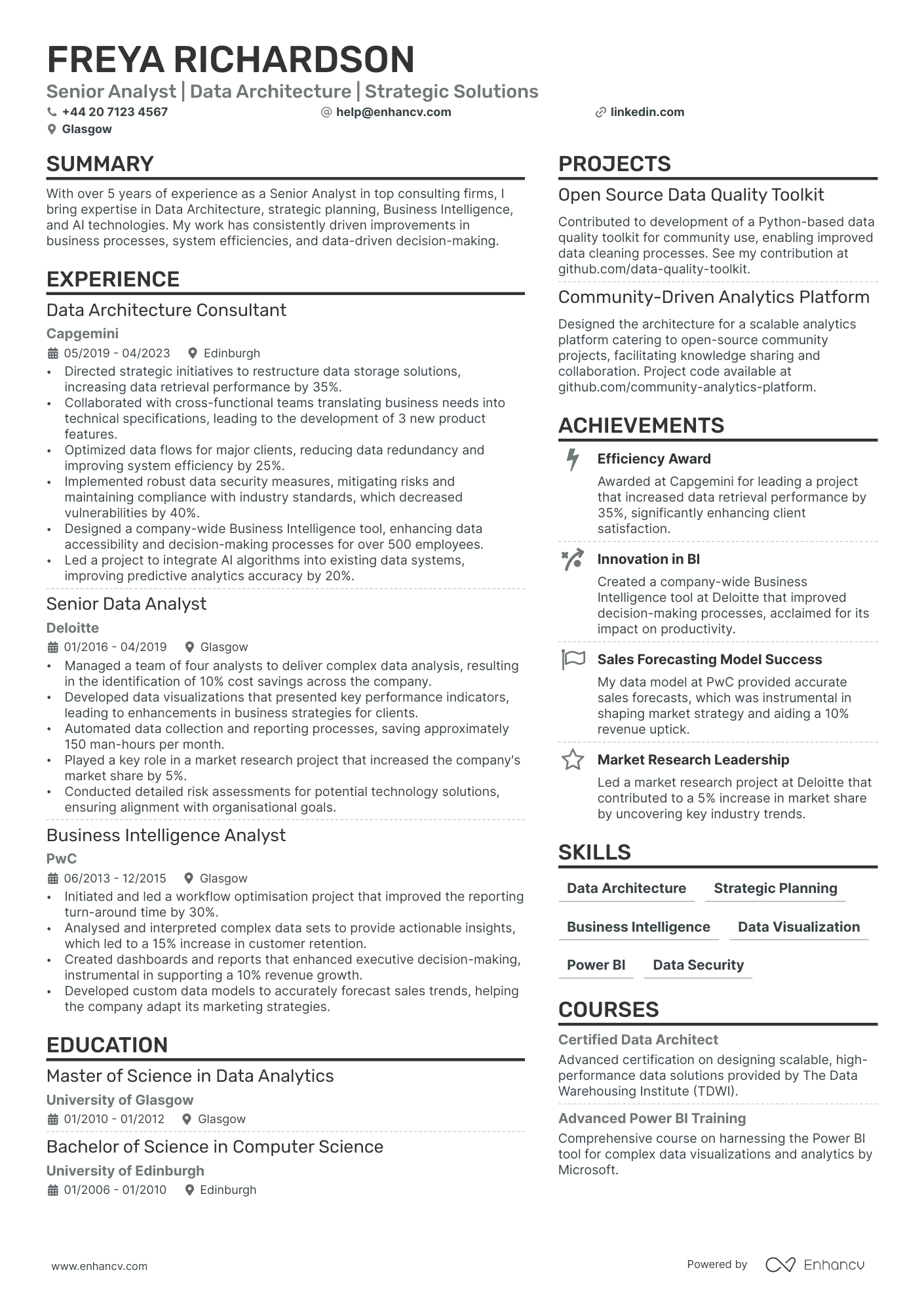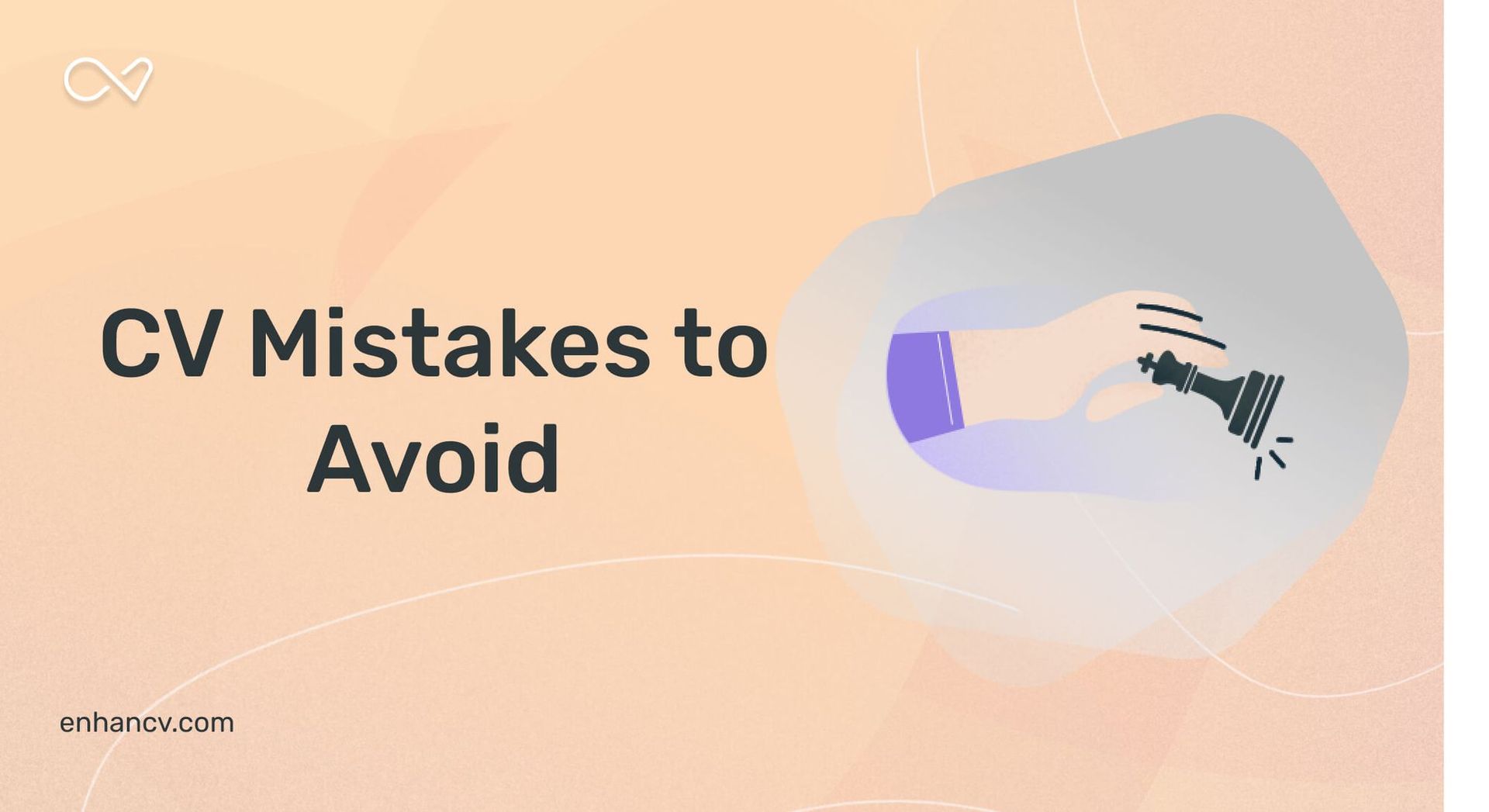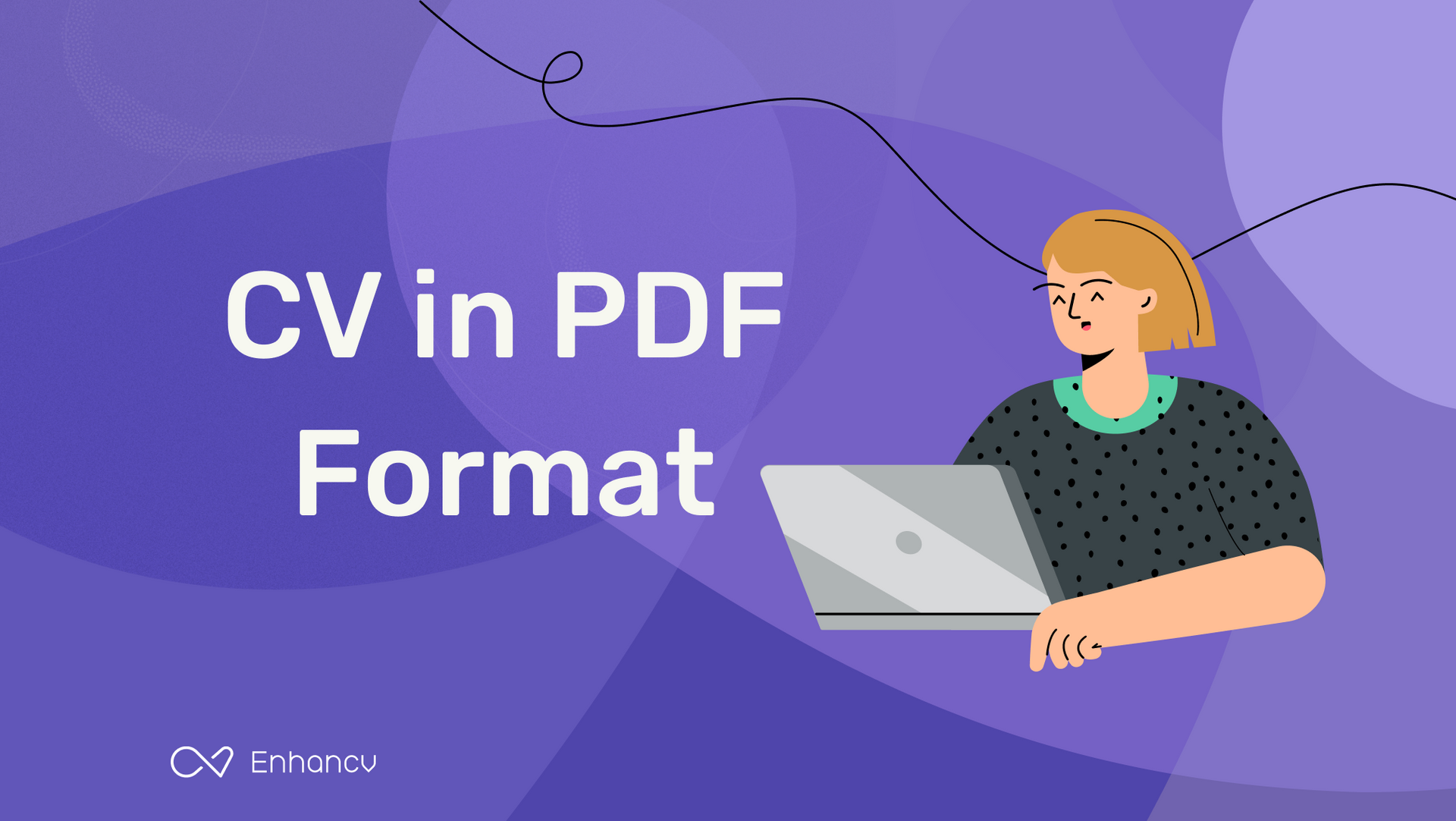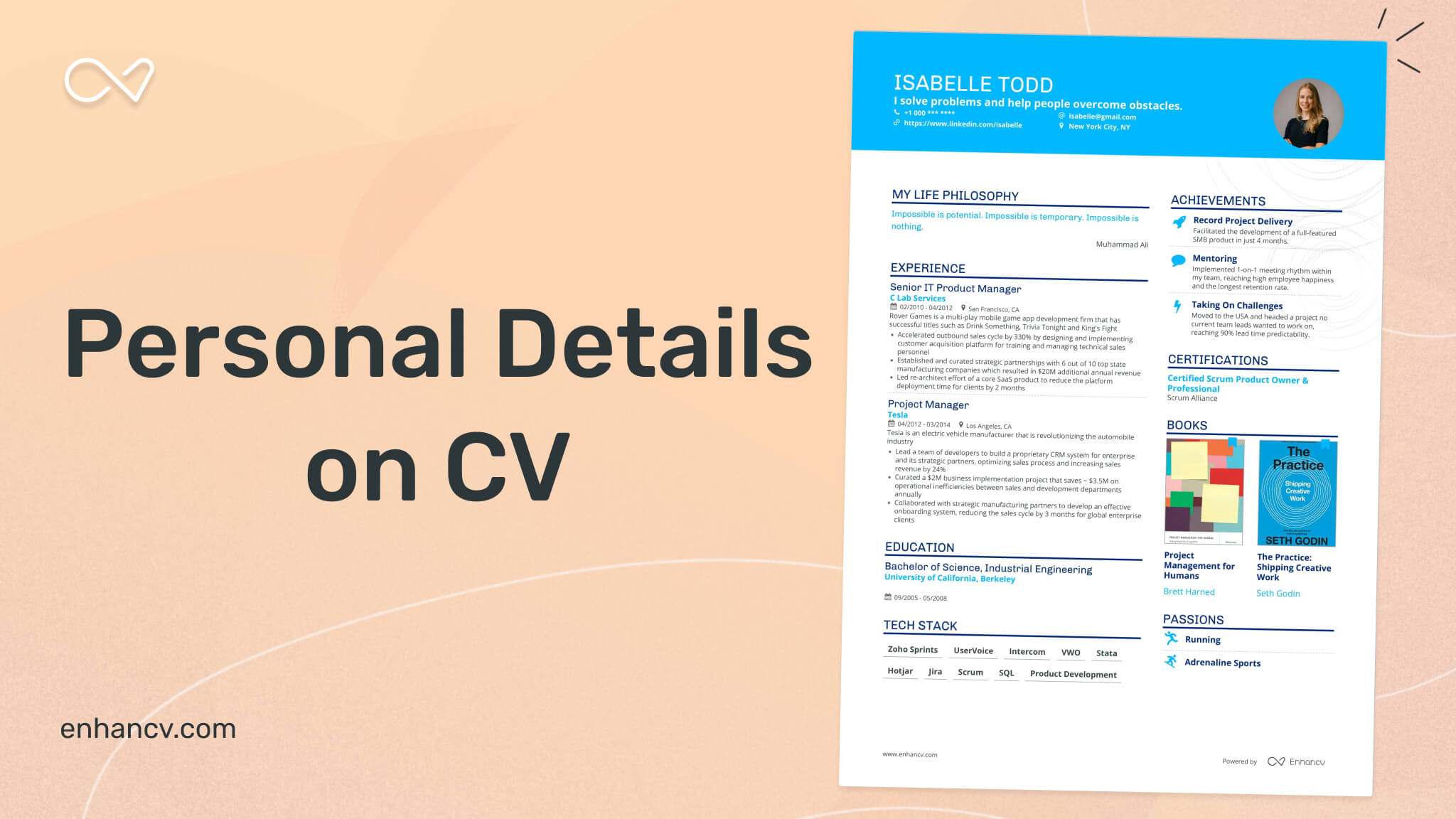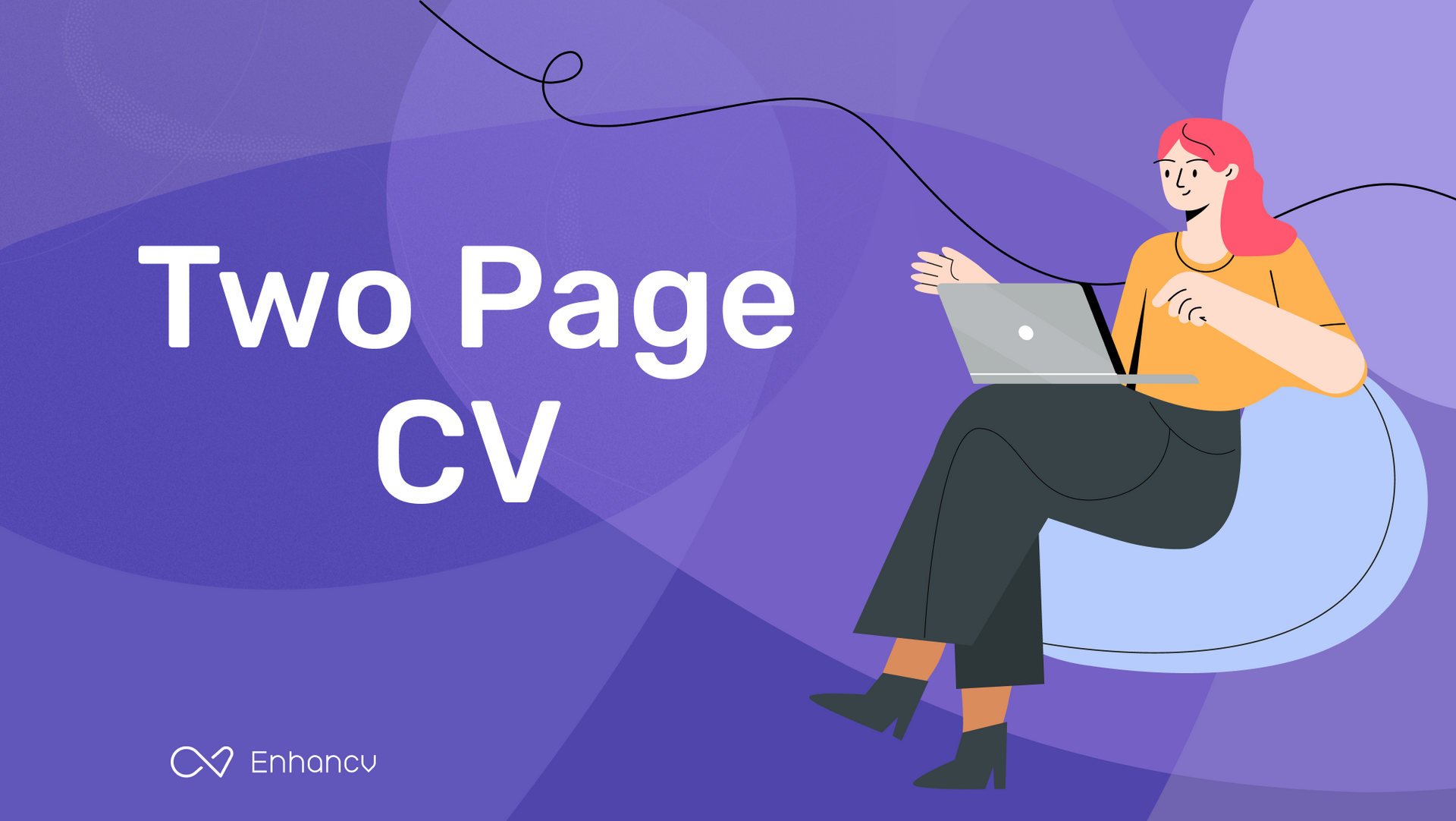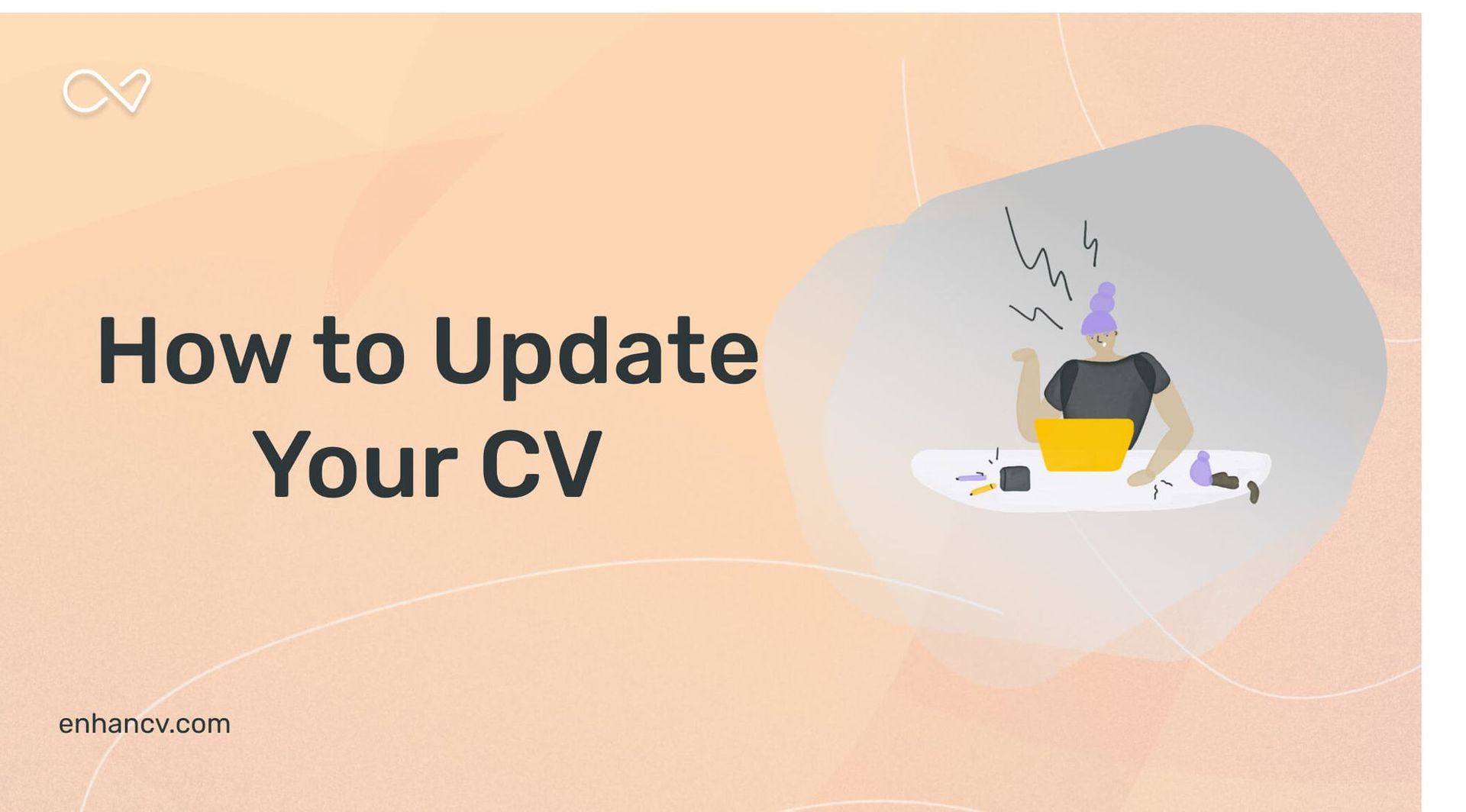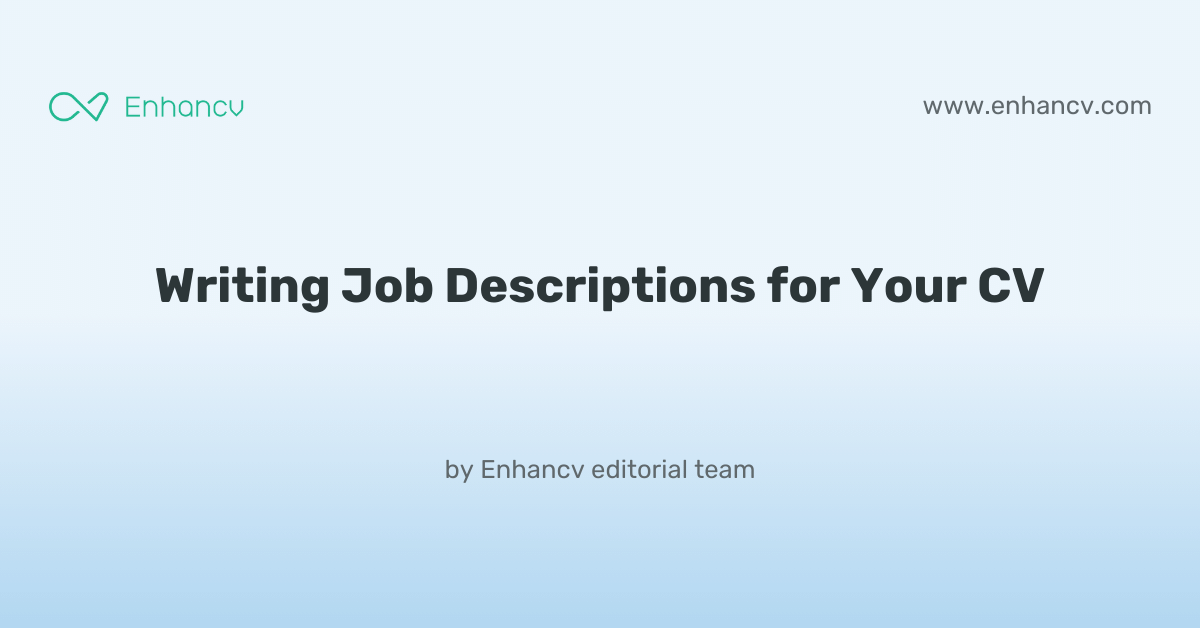Crafting a CV that effectively showcases the depth of your technical expertise and project management skills can be a daunting challenge as a data architect. Fortunately, our guide provides tailored strategies to help you highlight your most impressive accomplishments and convey the complexity of your role clearly and succinctly.
- Applying best practices from real-world examples to ensure your profile always meets recruiters' expectations;
- What to include in your work experience section, apart from your past roles and responsibilities?
- Why are both hard and soft skills important for your application?
- How do you need to format your CV to pass the Applicant Tracker Software (ATS) assessment?
If you're writing your CV for a niche data architect role, make sure to get some inspiration from professionals:
Structuring and formatting your data architect CV for an excellent first impression
The experts' best advice regarding your CV format is to keep it simple and concise. Recruiters assessing your CV are foremost looking out for candidates who match their ideal job profile. Your white space, borders, and margins. You may still be wondering which format you need to export your CV in. We recommend using the PDF one, as, upon being uploaded, it never alters your information or CV design. Before we move on to the actual content of your data architect CV, we'd like to remind you about the Applicant Tracker System (or the ATS). The ATS is a software that is sometimes used to initially assess your profile. Here's what you need to keep in mind about the ATS:- All serif and sans-serif fonts (e.g. Rubik, Volkhov, Exo 2 etc.) are ATS-friendly;
- Many candidates invest in Arial and Times New Roman, so avoid these fonts if you want your application to stand out;
- Both single and double column CVs can be read by the ATS, so it's entirely up to you to select your CV design.
PRO TIP
Use bold or italics sparingly to draw attention to key points, such as job titles, company names, or significant achievements. Overusing these formatting options can dilute their impact.
The top sections on a data architect CV
- Professional Summary displays your career objectives and expertise.
- Technical Skills outlines the specific databases and tools you master.
- Work Experience shows your real-world impact and projects.
- Education and Certifications affirm your formal training and qualifications.
- Key Projects section highlights major accomplishments and contributions.
What recruiters value on your CV:
- Demonstrate mastery of data architecture principles by highlighting major projects where you've designed scalable, reliable, and secure data solutions to show your technical prowess.
- Emphasise your experience with data modelling tools, databases (both SQL and NoSQL), and ETL frameworks, making sure to reference specific technologies relevant to the role.
- Include instances where you've successfully managed data governance and compliance, signifying your understanding of regulatory requirements and how to align architecture with business needs.
- Feature your skill in cloud-based solutions, such as AWS, Azure, or GCP, detailing any migrations or hybrid systems you've worked with to showcase versatility and up-to-date expertise.
- Articulate experience in developing data strategies, processes optimisation, and interoperability of systems to present a holistic understanding of data flows within a business context.
Recommended reads:
What information should you include in your data architect CV header?
The CV header is potentially the section that recruiters would refer to the most, as it should include your:
- Contact details - your professional (non-work) email address and phone number;
- Professional photograph - if you're applying hinting at the value you bring as a professional.
Many professionals often struggle with writing their data architect CV headline. That's why in the next section of this guide, we've curated examples of how you can optimise this space to pass any form of assessment.
Examples of good CV headlines for data architect:
- Lead Data Architect | Cloud Solutions Specialist | Certified Data Management Professional | 10+ Years Experience
- Senior Data Architect | AI & Machine Learning Integration | Master's in Data Science | 8 Years in Field
- Data Systems Architect | Big Data Analytics | Ph.D. in Computer Science | 12 Years Professional Expertise
- Junior Data Architect | Database Design Enthusiast | BSc Honours in Information Technology | 2 Years Hands-On Experience
- Data Infrastructure Architect | Enterprise Data Governance | Certified Solution Architect | 15+ Years Leadership
- Principal Data Architect | Real-Time Data Processing | ITIL Expert | 20 Years of Transformative Solutions
Opting between a data architect CV summary or objective
Within the top one third of your data architect CV, you have the opportunity to briefly summarise your best achievements or present your professional goals and dreams. Those two functions are met by either the CV summary or the objective.
- The summary is three-to-five sentences long and should narrate your best successes, while answering key requirements for the role. Select up to three skills which you can feature in your summary. Always aim to present what the actual outcomes were of using your particular skill set. The summary is an excellent choice for more experienced professionals.
- The objective is more focused on showcasing your unique value as a candidate and defining your dreams and ambitions. Think about highlighting how this current opportunity would answer your career vision. Also, about how you could help your potential employers grow. The objective matches the needs of less experienced candidates, who need to prove their skill set and, in particular, their soft skills.
Still not sure about how to write your CV opening statement? Use some best industry examples as inspiration:
CV summaries for a data architect job:
Narrating the details of your data architect CV experience section
Perhaps you've heard it time and time again, but, how you present your experience is what matters the most. Your CV experience section - that details your work history alongside your accomplishments - is the space to spotlight your unqiue expertise and talents. So, avoid solely listing your responsibilities, but instead:
- adverts' keywords and integrate those in your experience section;
- Use your CV to detail how you've been promoted in the past by including experience in the reverse chronological order.
Before you start writing your data architect CV experience section, dive into some industry-leading examples on how to structure your bullets.
Best practices for your CV's work experience section
- Designed and implemented robust data warehouse solutions facilitating business intelligence for a leading e-commerce company, achieving a 25% improvement in data retrieval times.
- Architected and optimised a multi-petabyte, cloud-based data lake, resulting in a 30% cost reduction by streamlining data processing pipelines for a finance enterprise.
- Developed an enterprise data strategy, including governance and quality frameworks, which reduced data inconsistencies by 40% across all departments for a healthcare provider.
- Led a cross-functional team in transitioning from a legacy database system to a modern NoSQL database, enhancing scalability and supporting a 50% increase in concurrent users.
- Orchestrated the data migration of 500 million customer records with zero downtime, employing cutting-edge ETL tools and rigorous testing protocols for a telecommunications firm.
- Authored comprehensive data models and entity-relationship diagrams that accurately represented business processes and reduced ambiguity in a multinational supply chain network.
- Established a real-time data analytics platform that empowered a retail company to respond to market trends promptly, increasing customer satisfaction by 20%.
- Collaborated with IT security experts to enforce data protection policies, successfully mitigating risks and adhering to GDPR and other relevant data protection regulations.
- Introduced agile and DevOps practices into the data architecture workflows, significantly reducing time-to-market for new data services in a dynamic startup environment.
- Designed and implemented a cloud-based data warehousing solution for a leading e-commerce platform, improving data retrieval times by 35%.
- Spearheaded the migration of 15TB of legacy data into modern, scalable storage systems, reducing data management costs by 25% annually.
- Developed robust data governance policies for sensitive customer information, ensuring compliance with GDPR and enhancing data security.
- Architected a real-time data analytics pipeline that supported a 40% increase in decision-making speed for marketing strategies.
- Collaborated with cross-functional teams to integrate heterogeneous data sources, achieving a unified view of business performance metrics.
- Optimized the SQL database handling 10 million records a day, resulting in a 50% reduction in processing time.
- Orchestrated the design and deployment of a distributed data storage solution, supporting a 20% year-on-year growth in data volume.
- Managed a team responsible for the successful implementation of BI solutions that improved reporting accuracy for the sales department.
- Introduced machine learning models to predict customer behaviour, enhancing targeted marketing campaigns and increasing conversion rates by 15%.
- Coordinated with stakeholders to refine business intelligence requirements, streamlining the collection and analysis processes.
- Played a pivotal role in the establishment of a company-wide data dictionary, improving data literacy and usage consistency across the organization.
- Crafted and executed a multi-cloud data strategy that provided high availability and disaster recovery options for critical business data.
- Designed an enterprise data model that facilitated a reduction in report generation time by 30%, directly impacting operational efficiency.
- Conducted thorough assessments of emerging data technologies, resulting in the adoption of a columnar database that saved £100K in annual licensing fees.
- Implemented a company-wide master data management program, ensuring data accuracy and consistency across all business units.
- Directed the construction of a scalable analytics platform that serviced over 200 users, providing insights into customer behaviour.
- Integrated geospatial analytics into the data platform, enriching business intelligence reports and improving logistics planning by 20%.
- Led the technical design and execution of a data lake project, consolidating disparate data sources for easier analysis and insight discovery.
- Developed a predictive analytics framework for a telecom giant, enhancing network optimisation and reducing operational costs by £5M annually.
- Designed a metadata management strategy that streamlined data integration efforts by 40%, those improving data delivery timelines.
- Established robust data security procedures that protected against data breaches and ensured business continuity under new cybersecurity threats.
- Enabled real-time data access for business analysts, driving faster and more informed decision-making processes across the company.
- Initiated the use of advanced ETL tools that reduced data loading times by 50%, thus expediting the availability of operational data.
- Harnessed the potential of big data technologies, facilitating the storage and processing of multi-structured data from diverse sources.
How to ensure your data architect CV stands out when you have no experience
This part of our step-by-step guide will help you substitute your experience section by helping you spotlight your skill set. First off, your ability to land your first job will depend on the time you take to assess precisely how you match the job requirements. Whether that's via your relevant education and courses, skill set, or any potential extracurricular activities. Next:
- Systematise your CV so that it spotlights your most relevant experience (whether that's your education or volunteer work) towards the top;
- Focus recruiters' attention to your transferrable skill set and in particular how your personality would be the perfect fit for the role;
- Consider how your current background has helped you build your technological understanding - whether you've created projects in your free time or as part of your uni degree;
- Ensure you've expanded on your teamwork capabilities with any relevant internships, part-time roles, or projects you've participated in the past.
Recommended reads:
PRO TIP
Describe how each job helped you grow or learn something new, showing a continuous development path in your career.
Mix and match hard and soft skills across your data architect CV
Your skill set play an equally valid role as your experience to your application. That is because recruiters are looking for both:
- hard skills or your aptitude in applying particular technologies
- soft skills or your ability to work in a team using your personal skills, e.g. leadership, time management, etc.
Are you wondering how you should include both hard and soft skills across your data architect CV? Use the:
- skills section to list between ten and twelve technologies that are part of the job requirement (and that you're capable to use);
- strengths and achievements section to detail how you've used particular hard and soft skills that led to great results for you at work;
- summary or objective to spotlight up to three skills that are crucial for the role and how they've helped you optimise your work processes.
One final note - when writing about the skills you have, make sure to match them exactly as they are written in the job ad. Take this precautionary measure to ensure your CV passes the Applicant Tracker System (ATS) assessment.
Top skills for your data architect CV:
Database design and modeling
SQL and NoSQL databases
Data warehousing solutions
ETL (Extract, Transform, Load) processes
Big data technologies (e.g., Hadoop, Spark)
Cloud computing platforms (e.g., AWS, Azure, GCP)
Data governance and compliance
Programming languages (e.g., Python, Java, Scala)
Data security and encryption methods
Performance tuning and optimization
Analytical thinking
Problem-solving
Effective communication
Leadership and team management
Attention to detail
Strategic planning
Project management
Time management
Continuous learning
Adaptability
PRO TIP
Use mini case studies or success stories in your CV to demonstrate how your skills have positively impacted previous roles or projects.
Further professional qualifications for your data architect CV: education and certificates
As you're nearing the end of your data architect CV, you may wonder what else will be relevant to the role. Recruiters are keen on understanding your academic background, as it teaches you an array of hard and soft skills. Create a dedicated education section that lists your:
- applicable higher education diplomas or ones that are at a postgraduate level;
- diploma, followed up with your higher education institution and start-graduation dates;
- extracurricular activities and honours, only if you deem that recruiters will find them impressive.
Follow a similar logic when presenting your certificates. Always select ones that will support your niche expertise and hint at what it's like to work with you. Balance both technical certification with soft skills courses to answer job requirements and company values. Wondering what the most sought out certificates are for the industry? Look no further:
PRO TIP
If there's a noticeable gap in your skillset for the role you're applying for, mention any steps you're taking to acquire these skills, such as online courses or self-study.
Recommended reads:
Key takeaways
Your successful job application depends on how you well you have aligned your data architect CV to the job description and portrayed your best skills and traits. Make sure to:
- Select your CV format, so that it ensures your experience is easy to read and understand;
- Include your professional contact details and a link to your portfolio, so that recruiters can easily get in touch with you and preview your work;
- Write a CV summary if you happen to have more relevant professional experience. Meanwhile, use the objective to showcase your career dreams and ambitions;
- In your CV experience section bullets, back up your individual skills and responsibilities with tangible achievements;
- Have a healthy balance between hard and soft skills to answer the job requirements and hint at your unique professional value.
